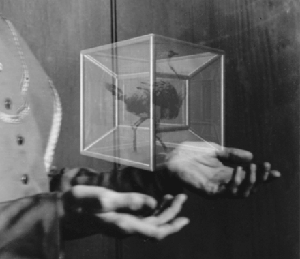What is the logic behind thinking that there isn't anything spherical inside a BH, but rather a /ring/disc/tube in there? Is it the "hope" that there is an entry to another world that drives this?
I would rather estimate that whats in the center of a BH is the most spherical objects in the universe - the surface os perfectly smooth the n:th grade and it is "very round" - as it is probably - sit down... still, as in not spinning and thus, have no girdle.
Again a first ever announcement here 😉
And btw - a BH don't contain a true singularity beacuse when that forms for the first ans only time (per stint) in the universe, the big crunch begins.
//
I would rather estimate that whats in the center of a BH is the most spherical objects in the universe - the surface os perfectly smooth the n:th grade and it is "very round" - as it is probably - sit down... still, as in not spinning and thus, have no girdle.
Again a first ever announcement here 😉
And btw - a BH don't contain a true singularity beacuse when that forms for the first ans only time (per stint) in the universe, the big crunch begins.
//
Last edited:
They still haven't identified a sample of dark energy. They're about to toss that theory in favor of another one. Where are the strings?Indeed.
Boggled about "Volume of a black hole", I found a paper where it is said the inside volume depends of the chosen metric for the space inside. Then they calculate different volumes using different metrics.
My understanding is: We don't know, the inside volume of a BH is not defined, it does not exist.
Why don't they say so ?
It seems to me, people are not able to say: "I do not know" ...and this is getting worse.
The whole system is BREAKING DOWN🙂
I don't get that reply - sorry. Tried all sorts of angels, context and imagination... but, no.
//
//
Cosmic strings, if they exist, would be extremely thin with diameters of the same order of magnitude as that of a proton, i.e. ~ 1 fm* or smaller. This is much smaller than any cosmological scale.How short is a string?😕
*The femtometre, symbol fm, is equal to 10^−15 metres.
P.S. Not to be confused with the string in string theory!
Last edited:
I seem to detect some negativity towards the scientific method amongst the audience. 😉
We must have patience! 😎
It's only been around 100 years since Einstein first introduced the quantum nature of light - something that, in 1921, would earn him the Nobel prize for his services to Theoretical Physics.
Much has been discovered in just the last 30 years or so:
What Is Quantum Computing? - Business Insider
Here's a question for you: Is it true that quantum computers are running their calculations in parallel universes? 😱
We must have patience! 😎
It's only been around 100 years since Einstein first introduced the quantum nature of light - something that, in 1921, would earn him the Nobel prize for his services to Theoretical Physics.
Much has been discovered in just the last 30 years or so:
- Quantum teleportation (1992)
- The creation of the first Bose-Einstein condensate (1995)
- The accelerating expansion of the universe (1997)
- Experimental proof that neutrinos have mass (1998)
- The sighting of the Higgs boson at Cern (2012)
- Gavitational waves are observed (2015)
- First image of a Black Hole (2019)
What Is Quantum Computing? - Business Insider
Here's a question for you: Is it true that quantum computers are running their calculations in parallel universes? 😱
Last edited:
Interesting to note that 120 years ago, we didn't even know the atom existed (although a Greek philosopher had postulated that all matter was made up of tiny 'indivisibles' about 2300 yrs ago).
If you think about the fact that we now have the Standard Model and can concoct molecules to order (think vaccine, genome splicing, materials sciences etc) just 120 yrs later I'd say that pretty amazing! 🙂
If you think about the fact that we now have the Standard Model and can concoct molecules to order (think vaccine, genome splicing, materials sciences etc) just 120 yrs later I'd say that pretty amazing! 🙂
I'm pretty glad so little is solved. What would we do after THAT! 😕
Three Royal Institution speakers, three different styles and topics.
Jim Baggott. Very calm. Loop Quantum Gravity:
Why Space Itself May Be Quantum in Nature - with Jim Baggott - YouTube
Current research at the LHC. Harry Cliff. Quite jumpy. Mostly K mesons and CP violation:
Beyond the Higgs: What's Next for the LHC? - with Harry Cliff - YouTube
And my favourite. Matt Parker. Hyperactive. Mathematical Magician amazes us with tricks:
Four Dimensional Maths: Things to See and Hear in the Fourth Dimension - with Matt Parker - YouTube

My money was on the Tesseract as his 4D favourite. But NO! Excellent animations. 😀
Three Royal Institution speakers, three different styles and topics.
Jim Baggott. Very calm. Loop Quantum Gravity:
Why Space Itself May Be Quantum in Nature - with Jim Baggott - YouTube
Current research at the LHC. Harry Cliff. Quite jumpy. Mostly K mesons and CP violation:
Beyond the Higgs: What's Next for the LHC? - with Harry Cliff - YouTube
And my favourite. Matt Parker. Hyperactive. Mathematical Magician amazes us with tricks:
Four Dimensional Maths: Things to See and Hear in the Fourth Dimension - with Matt Parker - YouTube

My money was on the Tesseract as his 4D favourite. But NO! Excellent animations. 😀
Indeed, and considering there was a gap of over 3 centuries between Newton's Law of Universal Gravitation and Einstein's General Theory of Relativity, our current rate of progression in physics is not all that slow!. . . just 120 yrs later I'd say that pretty amazing! 🙂

- The sighting of the Higgs boson at Cern (20
- Were you there? Remember they "say" they saw it. Let's see some pics.
How 'long' is a string?I don't get that reply - sorry. Tried all sorts of angels, context and imagination... but, no.
//

Were you there? Remember they "say" they saw it. Let's see some pics.
It's all here for you, Discopete. You gotta attend the lectures. 😀
Beyond the Higgs: What's Next for the LHC? - with Harry Cliff - YouTube
@Galu. I don't really get it myself.

But not a bad attempt to explain what is essentially a shadow in 3D:
Four Dimensional Maths: Things to See and Hear in the Fourth Dimension - with Matt Parker - YouTube
Naturally I liked the the LHC one. Biggest machine ever built. Fraught with difficult engineering problems. LHCb - Large Hadron Collider beauty experiment
There are no "pics" of the Higgs boson, scientists just see its footprint.Were you there? Remember they "say" they saw it. Let's see some pics.
This is a problem that scientists face when communicating with the public at large. The layman relies heavily on images to illustrate and represent complex scientific concepts.
For example, DNA is much too small for photographic treatment so visual artists and designers create images of the iconic double helix for public consumption.
In the case of the Higgs boson, while the audience expects to ‘see’ the physical form of the particle, this search is in vain. As particle physicists point out, it is impossible to actually visualize the subatomic particles.
That's because the Higgs boson isn’t really a ‘thing’ in the way that the layman might understand the term. Rather, it is a perturbation, a ripple in an energy field.
Analogy time! Looking at the attached image, we know a person or persons existed because they left behind their footprints!
Attachments
"My money was on the Tesseract as his 4D favourite. But NO! Excellent animations. "
Ah yes! The tesseract once again. Wonderful! Wonderful!
Ah yes! The tesseract once again. Wonderful! Wonderful!
LHC - the largest most complex machine ever built by humans. I was amazed at the raw computing power on tap. Mindboggling.
Well if it's a particle it has mass which makes it a thing. But in any case, were there observers there to verify the claims? Because...you know..scientists.
Last edited:
- Status
- Not open for further replies.
- Home
- Member Areas
- The Lounge
- What is the Universe expanding into..

